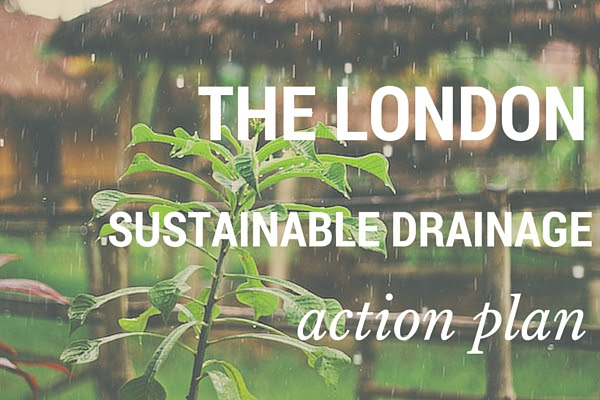This post originally appeared in the KLH Sustainability blog.
Sustainable drainage systems, or SuDS, are nothing new. The conventional method of managing stormwater is to transport collect and transport rainwater off site as quickly as possible via hard infrastructure systems. The rainwater is either discharged into the nearest receiving waters or sewage treatment plant, in the case of combined drainage systems.
SuDS, meanwhile, mimic natural systems to slow down, treat and use the water before or instead of sending it into sewers or directly to open water bodies. These systems can have additional benefits beyond managing quantities of water, including biodiversity enhancement, water treatment, reduced air pollution, amenity creation, reduction of the urban heat island effect and more.
Thanks to the multitude of benefits, SuDS are being used increasingly around the world. But in the face of increasing storm intensity, and an overburdened sewer system, how does London start incorporating these systems more quickly and reliably? This past October, the Greater London Authority released their London Sustainable Drainage Action Plan (LSDAP) for consultation. KLH Sustainability submitted comments on the plan, some of our observations are discussed below.
The vision set out in the plan is that: “By 2040, London will manage its rainwater sustainably to reduce flood risk and improve water security, maximising the benefits for people, the environment and the economy.” It outlines actions and a timeframe divided by sector to begin integrating SuDS into business as usual. The plan does a great job covering realistic and necessary actions that should be 100% achievable in the given time frame. However, as a plan, it is not very ambitious and is really only the first step towards making sustainable drainage part of the mainstream.
The key to implementing more sustainable practices is investment. In a very pragmatic way, the current plan relies on existing processes and funding streams as entry points to incorporate SuDS in to planned maintenance, replacement work and planned new projects. This is very important as it is the cheapest and easiest way to ensure this planned work is implemented correctly.
To move beyond incremental changes, there needs to be commitment to new sources of financial support and partnering. The LSDAP mentions Thames Water’s twenty4twenty £20m funding programme, which helps to identify other relevant parties interested in SUDs investment. Many programmes in the US have been successful in the increased implementation of SUDs through the use of demonstration projects, partnerships and incentives funded by central government, increased water management fees or partnership with the private sector.
Additional investment is also required to enforce the adoption of flood-related planning policies by local authorities. This leads to the second key observation: a lack of support to implement new and existing planning policies.
Last spring, SuDS were written into the National Planning Policy Framework, requiring most development to incorporate SuDS. At that time, the capacity within local authority was raised as a barrier to enforcement and it is not yet clear if the new London Action Plan has resolved this resource issue. The LSDAP should highlight how local authorities will be supported, whether through funding, expertise or enforcement. The LSDAP should use the forthcoming Sustainable Drainage Opportunity Model to identify high-risk geographic areas that are in particularly need of robust drainage requirements and enforcement.
There are additional aspects that could be included in the LSDAP, including:
- Defining the role NGOs, local community groups, retail partners, workforce groups like Groundwork UK, private landscaping firms and others could have in leading SuDS implementation in certain sectors or situations; and
- Further exploration of the role of grants or incentive schemes to encourage private residents and businesses to implement SuDS on their own.
The LSDAP target is “to achieve a 1% reduction in surface water flows in the sewer network each year for 25 years, resulting in a 25% reduction in flows by 2040.” The final piece of the puzzle is for the LSDAP to identify what financial benefits could be accrued through the delivery of that target using wide-spread, small-scale SuDS solutions rather than relying on expensive, single-purpose hard infrastructure solutions to handle storm flows. By articulating the long-term value of SuDS adoption across London, the LSDAP can demonstrate how sustainable drainage scheme can really contribute to a world-class, sustainable city.

